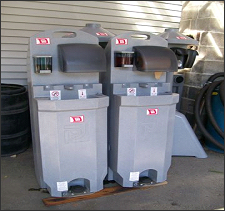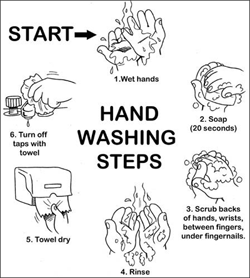
Subpart F | General Working Conditions in Shipyard Employment - Sanitation
This fact sheet describes the sanitation requirements of subpart F - General Working Conditions in Shipyard Employment, as specified in 29 CFR 1915.88. These provisions are effective August 1, 2011.

Portable hand washing facility
The absence of appropriate sanitation facilities can lead to adverse health effects in workers. In this regard, the lack of suitable sanitation facilities is well recognized as causing communicable diseases, heat-related illnesses, health effects related to delay in using the restroom, and the effects of ingesting or absorbing hazardous substances not properly removed from the workplace. Sanitation is especially important to shipyard employment, where unique working conditions often involve performing tasks in extreme weather conditions, as well as in remote locations. These conditions present a challenge for employers to ensure that they meet the sanitation needs of workers.
Sanitation Facilities
Facilities, including supplies, must be maintained for employee personal and health needs. Sanitation facilities include potable drinking water, toilet facilities, hand-washing and drying facilities, showers (including quick-drenching or flushing), changing rooms, eating and drinking areas, first aid stations, and on-site medical service areas. Sanitation supplies include: soap, waterless cleansing agents, single-use drinking cups, drinking water containers, toilet paper, and towels.
Toilet Facilities

A minimum number of toilets must be made available for employees at each worksite. These toilets must provide privacy, be separate for each sex, and maintained so they are clean, sanitary, and serviceable. Portable toilets may be included in meeting this minimum-number requirement when it is infeasible to provide sewered toilets at the worksite, or when there is a short-term, temporary increase in employment. Portable toilets must be vented and equipped with lighting when necessary. Examples of situations where portable toilets may be necessary include:
- At remote work locations, such as graving or dry docks, piers, or other locations, where it would be impracticable to run proper piping to install sewered toilets;
- When sewage systems are unavailable because they are shut down for repair, or when their use would result in the discharge of waste directly overboard in violation of environmental laws; or
- When employees are performing work at a location on a vessel that is far from a working sewered toilet.
Handwashing Facilities
Handwashing facilities must be available to workers at or adjacent to each toilet facility. Each handwashing facility must contain:

- Hot and cold or lukewarm running water and soap, or waterless skin-cleansing agents;
- Clean, single-use hand towels stored in a sanitary container; and
- A sanitary means for disposing of single-use hand towels.
Eating, Drinking, and Break Areas
Employees must not consume or store food, beverages, and tobacco products in any area where employee exposure to hazardous or toxic substances is possible. Employers may designate an area, free of hazardous or toxic substances, for employees to engage in these activities. In addition, employers must inform each employee engaged in the application of paints or coatings about the need to wash hands and face thoroughly before eating, drinking, or smoking. This requirement also applies to those employees performing other operations in which they can ingest or absorb hazardous or toxic substances. Employees also should be encouraged to remove surface contaminants at the end of their workshift.
Potable and Non-Potable Water
Potable water must be made available to all employees for health and personal needs. Employers must either provide a water fountain, single-use bottles, or a covered container with single-use cups stored in a sanitary receptacle. Non-potable water may be used for firefighting, cleaning outdoor areas, or other uses, provided that the water does not contain chemicals, fecal matter, coliform, or other substances that may be hazardous to workers. Employers must mark non-potable water as "Not safe for health or personal use."
Remember:

- Each sanitation facility must be (1) adequate in number for each worksite; (2) readily accessible; and (3) maintained in a clean, sanitary, and serviceable condition.
- With the exception of toilets and showers, employers have discretion to determine the adequate number of each sanitation facility (i.e., potable drinking water, hand-washing and drying facilities, changing rooms, eating and drinking areas, first aid stations, and on-site medical service areas) for their workplace.
- Employees must be able to reach these facilities without facing obstacles or delays. To help increase accessibility to these facilities, shipyard employers may provide portable toilets on docks adjacent to vessels when it is infeasible to provide sewered toilets, or provide waterless cleansing agents for handwashing purposes when supplying running water is impractical.
- A schedule for maintaining all sanitation facilities in a clean, sanitary, and serviceable condition must be established and implemented. This schedule must include servicing, cleaning, and the replenishment of supplies.
This is one in a series of informational fact sheets highlighting OSHA programs, policies or standards. It does not impose any new compliance requirements. For a comprehensive list of compliance requirements of OSHA standards or regulation, refer to Title 29 of the Code of Federal Regulations. This information will be made available to sensory-impaired individuals upon request. The voice phone is (202) 693-1999; teletypewriter (TTY) number: (877) 889-5627.
For more complete information:

Occupational Safety and Health Administration
U.S. Department of Labor www.osha.gov (800) 321-OSHA

